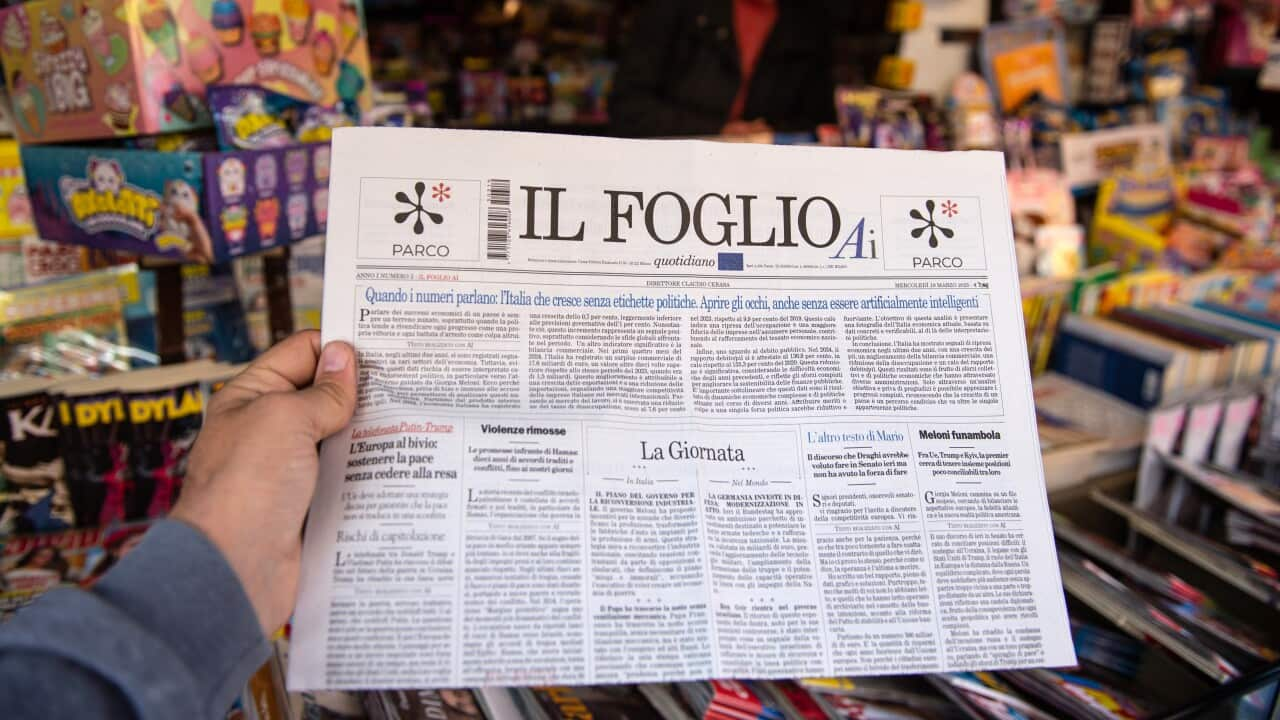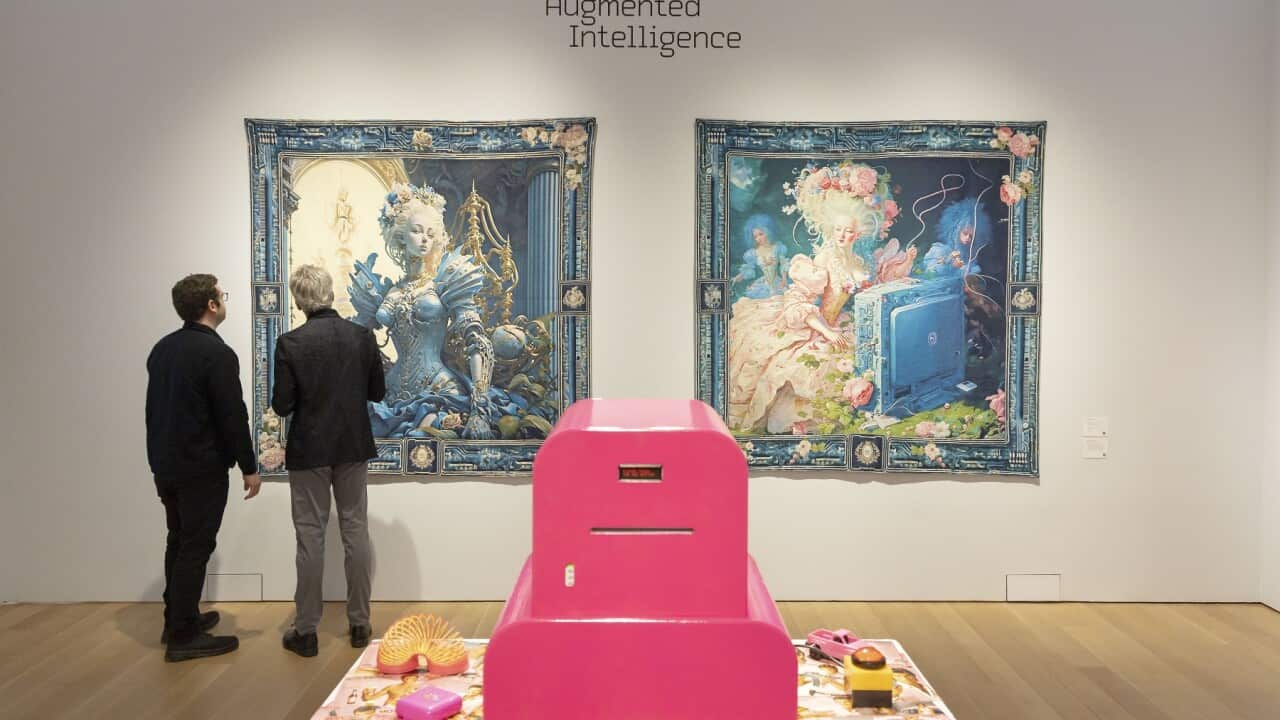Key Points
- Italian newspaper Il Foglio is publishing an edition entirely produced by artificial intelligence.
- The month-long 'experiment' has sparked debate around human contribution in journalism.
- Media experts say Australia lags behind much of the world in regulating AI.
Italian journalist Giulia Pompili isn't too concerned about the impact of artificial intelligence on her job.
Her newspaper, Il Foglio, is running a month-long experiment to publish stories entirely produced by AI.
"Our newspaper loves experimenting and we are all used to experimenting, so this hasn't struck us as a threat," she added.

Italian journalist Giulia Pompili says her newspaper wanted to "communicate that we can take advantage of artificial intelligence and need not be terrified by it". Credit: Il Foglio
It contains no stories written, or edited, by humans.
At the launch in March, the editorial team confirmed that Chat GPT would be used "for everything: writing, headlines, subheadings, quotes, summaries and sometimes irony as well".
Journalists "will be simply asking questions".
LISTEN TO

Si può scrivere un giornale con l'intelligenza artificiale?
SBS Italian
15:55
'Quite brave, but ultimately pointless'
Monica Attard OAM worked at ABC for 30 years across radio and television, and she is now head of journalism at UTS and co-director of the UTS Centre for Media Transition.
Her feelings on Il Foglio's experiment are mixed.
"It's actually quite brave, but ultimately pointless, because it'll tell us what we already know," she told SBS Italian.
Attard cited the work of NewsGuard, an "information integrity organisation" based in New York, which has identified thousands of websites focusing on various subjects that are "completely generated by generative AI with no human input, no policies on the website, no editor listed on the website".
"Now those websites can be very, very dangerous," she warned.
Trust and accountability play an essential role in journalism, which explains why Il Foglio's experiment has caused such a stir internationally.

Monica Attard, head of journalism at UTS, says there needs to be greater understanding about the misinformation produced by generative AI. Credit: Supplied by Monica Attard
"I don't really think that audiences want fully AI-produced journalism," he said.
"That's not what the research shows at all."
What does the experiment show?
According to Pompili, so far there has been only one occasion when Il Foglio management prevented the publication of an AI-generated article.
"We asked about hate crimes in Europe and AI couldn't find enough examples and so it started making some up," she said.
Other "less invalidating" inaccuracies and mistakes were left in Il Foglio AI, and letters to the editor were generated by AI, which was also replying to them.
Moreover, reviews were published on books "that AI had obviously not read," she said.
Il Foglio AI is being sold together with the traditional human-produced version of the newspaper for about a month.
In the AI copy, every article is clearly labelled as AI-generated, but Attard said such disclaimers may not be enough.
"I don't believe that the public understands the dangers of misinformation produced by generative AI sufficiently at this point in time," she said.
Pompili also issued a warning.
AI sometimes lies. It doesn't do it with human malice, but sometimes its answers are blatantly wrong.Giulia Pompili, journalist at Il Foglio
Inaccuracies are not the only issues when using AI to generate content, Thomson said.
"There's no kind of primary contribution, you know, actually talking to people, getting new insights, getting new context, so it's kind of just recycling what we already have out there on the internet," he said.
"And the internet is already kind of full of recycled secondhand content."
How is Australian media coping with AI?
There are very few legal boundaries with how AI can be used, Thomson said, and these are limited to "legacy rules".
Things like plagiarism or defamation can still apply to AI-generated content, but nothing specific has been created to regulate this very new and ever-expanding area.
"Australia's been caught kind of at the back of the pack in terms of regulating AI," he said.
"We have a lot of work to do to catch up to places like Europe that have been working for many, many years on regulating AI."

Dr TJ Thomson says Australia must catch up to other countries regarding AI regulation. Credit: Anthony Weate
"From the research that we're doing at the moment, even very, very large mainstream newsrooms are experimenting (with AI), and they're experimenting with a view to creating a new set of editorial guidelines and policies that protect the integrity of the reportage that they produce," she said.
"So I think for the next few years that's what we can expect to see in Australia."
Ethical boundaries are still being debated, according to Thomson.
"It's very scattershot. You have kind of really big organisations that have developed AI policies, but our research suggests that medium and smaller sized organisations don't yet have policies in place," he said.
"Perhaps a little bit more troublingly, even if people do have policies in place, news audiences don't really understand what the policies mean or aren't even aware of the policies existing".
A lot of the news audiences that we talked to have said 'I don't really know whether I've encountered AI's effects in journalism'. They're really unsure, they suspect they have, but they don't know.Dr TJ Thomson, senior lecturer at RMIT University
What does the future hold?
According to Pompili, Il Foglio's "crazy" experiment was partly about having fun — but not just for fun's sake.
They wanted to "communicate that we can take advantage of artificial intelligence and need not be terrified by it," she said.
Thomson acknowledged that "AI can help journalists do their jobs better" and "help them tackle stories they couldn't otherwise tackle".
But Attard said there is a key distinction between generic AI and generative AI.
"Generic AI has been around for quite a long time, we use AI services to transcribe interviews, from voice to text, video to voice, video to text, we use AI to maximise reach to audiences, that's very, very common," she explained.
"Generative AI is generating words, generating sentences, generating stories. That's a very, very different thing."
Experts agree that AI will lead to job losses and some signs have already started to appear.
"Publishers like ACM have announced quite significant job cuts over the last months, in part because of AI, in part because of streamlining," Thomson said.
"I think that trend will unfortunately continue."
But, in 2025, there also appears to be a consensus on how human contribution will always be necessary in journalism.
Pompili said that "from day zero" of Il Foglio AI, it was clear that "going from 0 to 1 can only be achieved by the human mind and intelligence".
According to Thomson, "journalists and humans have lots of unique capabilities, talents, skills, the ability to empathise with people, the ability to show emotion, the ability to have judgement and value, which machines can't replicate, at least not yet."
Attard shared a similar perspective.
"AI will never be able to to speak, it can't speak to people. It can't gain an idea or a feeling of the way people are reacting to situations," she said.
Somebody has to speak to people, somebody has to actually elicit human emotional response. A computer can't do that.Monica Attard, head of journalism at UTS



